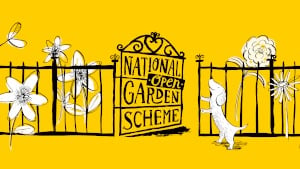About Port Navas Chapel
The Port Navas Chapel Garden was designed by Keith Wilkins and built with the help of his partner, Linda World and occasional help from Matt, Joe, Josh and especially Mike. Most of the stones came from Tim Marsh’s quarry in nearby Mabe. When the garden was started in 2016, the plot was full of brambles, nettles, old boats and rusty trailers, even an old mattress! The neighbours complained about it being a rubbish dump! The first few years were spent clearing away all the rubbish, brambles and nettles and gradually a plan was developed and some heavy equipment brought in to landscape the pond, driveway and other features. The plot then looked a bit like a building site!
This is the 5th garden that Keith has designed and built, all based on his love of Japanese Gardens, which he has been studying for about 40 years. This garden is the 3rd that has been open under the National Garden Scheme. Design influences have been from the many books on Japanese and Chinese gardens, a visit to Kyoto in Japan and many other Japanese gardens around the world. Most of all, much has been learnt by the study of nature in the wild. The most influential garden has been the Katsura Palace Garden in Kyoto.
Much time and care is spent in the balanced positioning and placement of rocks and trees to give a harmonious affect. In a Japanese Stroll Garden much emphasis is also placed on providing ‘viewpoints’ to all parts of the garden, which are relaxing to the eye and soothing to the mind.
The design of the garden is calculated to induce a feeling of calm and tranquillity in the observer by providing a landscape that is harmonious and where nothing ‘jars’ on the eye if possible. When everything is in balance, which occurs in nature, (although we are not always aware of it) then the whole visual experience transcends that of the many parts, affecting us on many levels at once. If this is how the garden affects you – then the design has succeeded.
Whilst the visual aspect is important, Japanese Gardens appeal to all the senses – sight, sound, smell and touch. Each of the water pumps in the garden are fitted with flow controls in order that the sound of the water can be adjusted. It is important that the sound should be somewhere between a trickle and a ‘gush’ and thus add to the overall effect. Birds are encouraged to populate the garden – in order that they contribute to the background sounds. Similarly, scents of plants and flowers should be subtle and not overpowering. Textures, too, have an important part to play in providing the right ’feel’ when walking over the different pathways and grass – giving a pleasant variety of sensations.
On the visual side, colour has a very important role to play in the overall calming effect. The garden is designed to provide colour throughout the year and by the subtle blend of green grey, gold and yellow evergreen foliage, the sight is rewarded with a relaxing canopy in darkest winter or on a hot summer’s day. Bold washes of flowers in bright prime colours may be very pretty – but they are not calming the mind – they are over exciting it, like a funfair does. They have no place in a Japanese garden.
To harmonise is to be in tune with nature and this philosophy extends to the way we treat all living things. They must have the respect that they deserve. Therefore, as well as catering for all living things, the garden is as organic as possible and the use of all pesticides has been taboo for four years now, so that fish, birds and other smaller animals are not harmed.

.jpg)
.jpg)
.jpg)
.jpg)
.jpg)
.jpg)
.jpg)
.jpg)
.jpg)
.jpg)
.jpg)
.jpg)
.jpg)
.jpg)
.jpg)
.jpg)
.jpg)
.jpg)


.jpg)

.jpg)
.jpg)
.jpg)
.jpg)
.jpg)